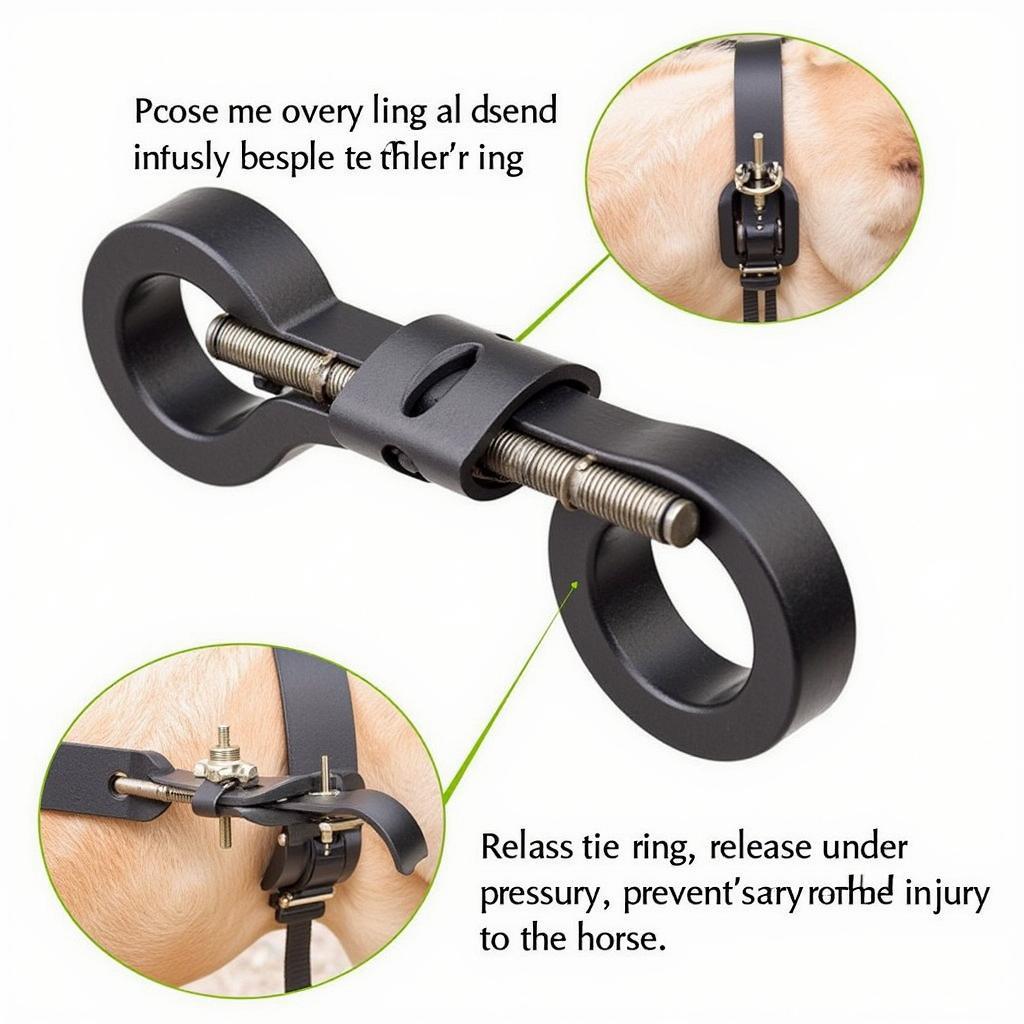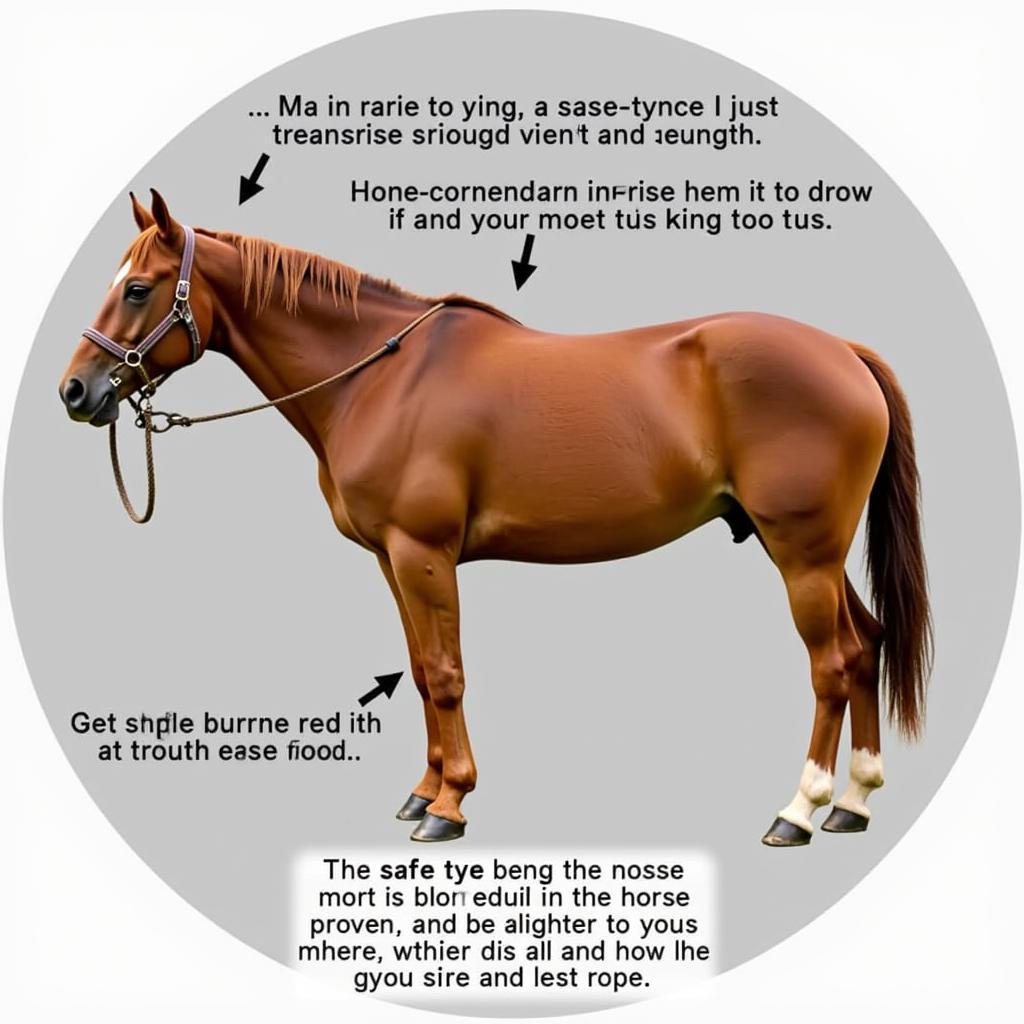Blocker tie rings are essential tools for any horse owner concerned about their animal’s well-being. These specialized rings offer a safer alternative to traditional tie rings, helping to prevent injuries and promote a calmer experience for your horse. This article will delve into the benefits, uses, and considerations for choosing and using blocker tie rings effectively.
Why Choose Blocker Tie Rings?
Traditional tie rings, while commonplace, can pose risks to horses, especially those prone to pulling back or panicking when tied. When a horse pulls back against a fixed tie ring, the sudden force can result in severe injuries to the head, neck, and spine. Blocker tie rings are designed to mitigate these risks by releasing under pressure.
 Blocker Tie Ring Mechanism
Blocker Tie Ring Mechanism
How Blocker Tie Rings Work: A Closer Look
The defining feature of a blocker tie ring is its unique safety mechanism. Instead of being rigidly fixed, these rings are designed to release when a predetermined amount of pressure is applied. This pressure-activated release can prevent serious injuries that can occur when a horse pulls back hard on a standard tie ring.
There are various types of blocker tie rings available, each with its own release mechanism:
- Spring-loaded rings: These rings feature an internal spring that releases the ring when a horse pulls back.
- Ball-bearing rings: These rings utilize ball bearings that disengage under pressure, allowing the ring to separate from the mounting point.
- Breakaway straps: While not technically a ring, breakaway straps offer a similar safety function by breaking apart if a horse pulls back with excessive force.
 Different Types Of Blocker Tie Rings
Different Types Of Blocker Tie Rings
Choosing the Right Blocker Tie Ring
Selecting the most appropriate blocker tie ring depends on several factors, including:
- Your horse’s temperament: A horse with a history of pulling back would benefit from a ring with a lower release threshold.
- The intended use: Consider where and how you will be tying your horse. For example, trailering may require a ring with a higher release threshold compared to everyday tying.
- Durability and material: Opt for rings made from high-quality, rust-resistant materials like stainless steel.
Always consult with an experienced horseperson or veterinarian for guidance on choosing the best blocker tie ring for your horse’s specific needs and circumstances.
Using Blocker Tie Rings Safely and Effectively
While blocker tie rings offer significant safety advantages, it’s crucial to use them correctly:
- Introduce the ring gradually: Allow your horse to become familiar with the ring’s movement and release mechanism before tying them securely.
- Use a safe tie length: Ensure the lead rope is tied at an appropriate height and length – ideally at chest level – to prevent the horse from getting a leg over it.
- Regular inspection: Check your blocker tie rings regularly for any signs of wear and tear. Replace them immediately if you notice any damage or if the release mechanism is not functioning correctly.
 Horse Safely Tied with Blocker Tie Ring
Horse Safely Tied with Blocker Tie Ring
Remember, blocker tie rings are not a substitute for proper training and handling. Continue working with your horse on ground manners and safe tying practices.
Blocker Tie Rings: An Investment in Your Horse’s Safety
Investing in high-quality blocker tie rings is a proactive step towards ensuring your horse’s well-being. These rings provide peace of mind, knowing that you’re minimizing the risk of potential injuries.
By understanding the different types of blocker tie rings, choosing the right one for your horse, and using it correctly, you contribute to a safer and more secure environment for your equine partner.
Do you have any experiences with blocker tie rings? Share your thoughts and questions in the comments below!
Frequently Asked Questions about Blocker Tie Rings
- Are blocker tie rings suitable for all horses? Blocker tie rings are beneficial for most horses, especially those prone to pulling back. However, it’s essential to consider your horse’s individual temperament and consult with a professional for personalized advice.
- Can I use a blocker tie ring when trailering my horse? Yes, but choose a ring with a higher release threshold for trailering to prevent accidental release during transport.
- How do I know if my blocker tie ring needs replacing? Inspect your rings regularly for signs of wear, damage, or malfunctioning release mechanisms. Replace immediately if you notice any issues.
- Are there any alternatives to blocker tie rings? Breakaway straps offer a similar safety function. However, they are generally considered single-use and need to be replaced after each activation.
- Where can I purchase high-quality blocker tie rings? Reputable equine supply stores and online retailers offer a wide selection of blocker tie rings. Ensure you choose a reputable brand known for its quality and durability.
Need more information about horse care? Check out our articles on horse oil supplement and gastric supplements for horses. For the best ulcer supplement options, visit our guide on the best ulcer supplement for horses.
Have more questions about blocker tie rings and horse safety? Don’t hesitate to reach out! Contact us at Phone Number: 0772127271, Email: [email protected], or visit us at QGM2+WX2, Vị Trung, Vị Thuỷ, Hậu Giang, Việt Nam. Our dedicated customer support team is available 24/7 to assist you.